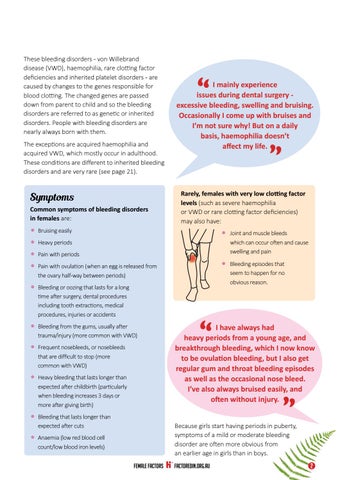These bleeding disorders - von Willebrand disease (VWD), haemophilia, rare clotting factor deficiencies and inherited platelet disorders - are caused by changes to the genes responsible for blood clotting. The changed genes are passed down from parent to child and so the bleeding disorders are referred to as genetic or inherited disorders. People with bleeding disorders are nearly always born with them. The exceptions are acquired haemophilia and acquired VWD, which mostly occur in adulthood. These conditions are different to inherited bleeding disorders and are very rare (see page 21).
Symptoms
Common symptoms of bleeding disorders in females are:
• Bruising easily • Heavy periods • Pain with periods • Pain with ovulation (when an egg is released from
I mainly experience issues during dental surgery excessive bleeding, swelling and bruising. Occasionally I come up with bruises and I’m not sure why! But on a daily basis, haemophilia doesn’t affect my life.
Rarely, females with very low clotting factor levels (such as severe haemophilia or VWD or rare clotting factor deficiencies) may also have:
• Joint and muscle bleeds
which can occur often and cause swelling and pain
• Bleeding episodes that
seem to happen for no obvious reason.
the ovary half-way between periods)
• Bleeding or oozing that lasts for a long time after surgery, dental procedures including tooth extractions, medical procedures, injuries or accidents
• Bleeding from the gums, usually after
trauma/injury (more common with VWD)
• Frequent nosebleeds, or nosebleeds that are difficult to stop (more common with VWD)
• Heavy bleeding that lasts longer than
expected after childbirth (particularly when bleeding increases 3 days or more after giving birth)
• Bleeding that lasts longer than
I have always had heavy periods from a young age, and breakthrough bleeding, which I now know to be ovulation bleeding, but I also get regular gum and throat bleeding episodes as well as the occasional nose bleed. I’ve also always bruised easily, and often without injury. Because girls start having periods in puberty, symptoms of a mild or moderate bleeding disorder are often more obvious from an earlier age in girls than in boys.
expected after cuts
• Anaemia (low red blood cell
count/low blood iron levels) FEMALE FACTORS
FACTOREDIN.ORG.AU
2
